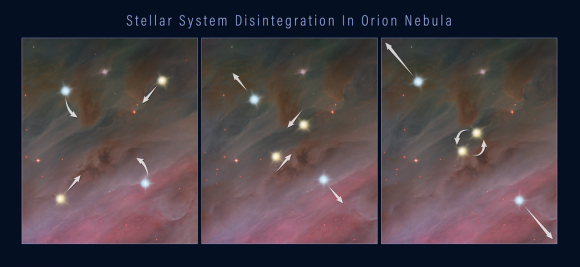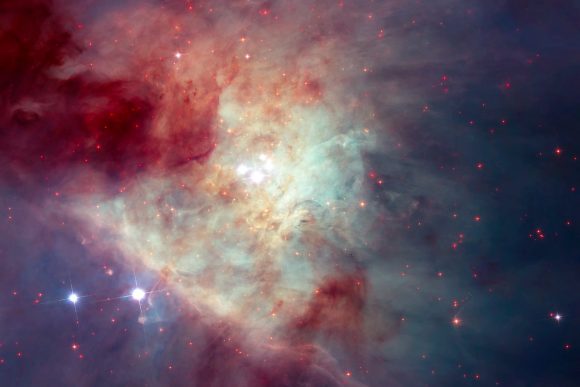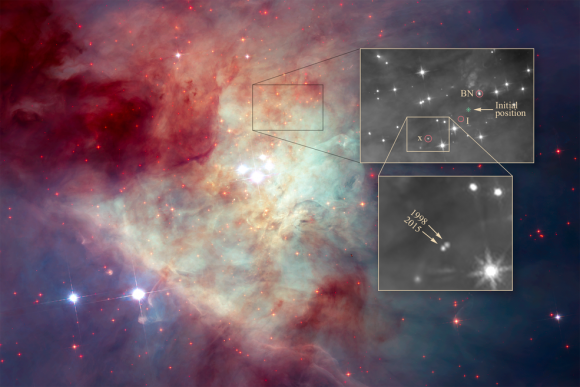It sometimes doesn’t take much to tear a family apart. A Christmas dinner gone wrong can do that. But for a family of stars to be torn apart, something really huge has to happen.
The dramatic break-up of a family of stars played itself out in the Orion Nebula, about 600 years ago. The Orion Nebula is one of the most studied objects in our galaxy. It’s an active star forming region, where much of the star birth is concealed behind clouds of dust. Advances in infrared and radio astronomy have allowed us to peer into the Nebula, and to watch a stellar drama unfolding.

Credits: NASA, ESA, and Z. Levy (STScI)
Over the last few decades, observations showed the two of the stars in our young family travelling off in different directions. In fact, they were travelling in opposite directions, and moving at very high speeds. Much higher than stars normally travel at. What caused it?
Astronomers were able to piece the story together by re-tracing the positions of both stars back 540 years. All those centuries ago, around the same time that it was dawning on humanity that Earth revolved around the Sun instead of the other way around, both of the speeding stars were in the same location. This suggested that the two were part of a star system that had broken up for some reason. But their combined energy didn’t add up.
Now, the Hubble has provided another clue to the whole story, by spotting a third runaway star. They traced the third star’s path back 540 years and found that it originated in the same location as the others. That location? An area near the center of the Orion Nebula called the Kleinmann-Low Nebula.

The team behind these new results, led by Kevin Luhman of Penn State University, will release their findings in the March 20, 2017 issue of The Astrophysical Journal Letters.
“The new Hubble observations provide very strong evidence that the three stars were ejected from a multiple-star system,” said Luhman. “Astronomers had previously found a few other examples of fast-moving stars that trace back to multiple-star systems, and therefore were likely ejected. But these three stars are the youngest examples of such ejected stars. They’re probably only a few hundred thousand years old. In fact, based on infrared images, the stars are still young enough to have disks of material leftover from their formation.”

“The Orion Nebula could be surrounded by additional fledging stars that were ejected from it in the past and are now streaming away into space.” – Lead Researcher Kevin Luhman, Penn State University.
The three stars are travelling about 30 times faster than most of the Nebula’s other stellar inhabitants. Theory has predicted the phenomenon of these breakups in regions where newborn stars are crowded together. These gravitational back-and-forths are inevitable. “But we haven’t observed many examples, especially in very young clusters,” Luhman said. “The Orion Nebula could be surrounded by additional fledging stars that were ejected from it in the past and are now streaming away into space.”
The key to this mystery is the recently discovered third star. But this star, the so-called “source x”, was discovered by accident. Luhman is part of a team using the Hubble to hunt for free-floating planets in the Orion Nebula. A comparison of Hubble infrared images from 2015 with images from 1998 showed that source x had changed its position. This indicated that the star was moving at a speed of about 130,000 miles per hour.

Credits: NASA, ESA, K. Luhman (Penn State University), and M. Robberto (STScI)
Luhmann then re-traced source x’s path and it led to the same position as the other 3 runaway stars 540 years ago: the Kleinmann-Low Nebula.
According to Luhmann, the three stars were most likely ejected from their system due to gravitational fluctuations that should be common in a high-population area of newly-born stars. Two of the stars can come very close together, either forming a tight binary system or even merging. That throws the gravitational parameters of the system out of whack, and other stars can be ejected. The ejection of those stars can also cause fingers of matter to flow out of the system.
As we get more powerful telescopes operating in the infrared, we should be able to clarify exactly what happens in areas of intense star formation like the Orion Nebula and its embedded Kleinmann-Low Nebula. The James Webb Space Telescope should advance our understanding greatly. If that’s the case, then not only will the details of star birth and formation become much clearer, but so will the break up of young families of stars.


How did any one know to focus in on, and enlarge this particular area of the nebula?
It’s the same mystery to me, as when some one decides to find what is believed to be the most distant and oldest galaxy.
With the whole universe to look in, how do you know?
I am constantly amused by the terminology used in these supposedly scientific reports/articles.
“Family” of stars…..really? Like one gave birth to another or they are genetically related?
I guess what you are referring to is that they have formed in close proximity and are relatively near to each other.
This would be accounted for by recent NASA missions that found that stars form along “filaments” in “virtual star nurseries”.
The astrophysics community should be ridiculed for their lack of attention to this information. You should also be personally embarrassed for propagating the ignorance as if it should be accepted without further comment.
It must be a dream come true to be making a living by writing nonsense about a field of science that has aborted the scientific method and hidden itself in a mathematically derived science fiction.
The gravity based standard model is being invalidated on a daily basis by the latest data from all radio telescope missions.
I”ll make my case by looking at your current diatribe, starting with your use of the term “family” of stars. This type of communication clearly shows a disrespect for your readers and an expectation that they are too stupid to notice the lack of any real meaning or understanding for this “family”.
Recent NASA missions have reported that stars form along “filaments” in “virtual star nurseries”. This is not a familial or genetic event as the word “family” implies. The failure to address and to overlook this finding is mind-boggling.
If the findings were acknowledged and admitted to be poorly understood that would at least be honest. But we both know this is not the case. These findings directly support the electromagnetic model of star formation as recently stated by Dr. Donald Scott. The “filaments” are in fact intergalactic and intra-galactic Birkeland currents and the occurrence of Z pinches by the magnetic fields along the currents result in star formation. Visualization of the currents depends on the state of the double layered plasma sheaths in which they travel……some are not seen while in the dark mode and others light up as they enter the glow mode. This is basic plasma physics by the way.
Dr. Scott is one of the premier academic authorities in electrical engineering in the U.S., having written the current graduate level textbook used for all graduate electrical engineering programs in the U.S.. So it’s useless to attack his credentials.
It would be a better use of your time to view his presentation to NASA at the 2009 Goddard Colloquim on Engineering. It might encourage you to educate yourself so that you can actually contribute to the correct understanding of cosmology today.
As an afterthought, you may first want to review Dr. Scott’s paper ” Modelling Birkeland Currents”…..he will receive a Nobel for this work eventually. However he is the first to admit that his work would have been impossible without the prior work of Kristen Birkeland (Nobel winner), Ralph Jeurgens and Hannes Alfvens (who himself has already won a Nobel in plasma physics). I just hope that Scott does not suffer as Birkeland did. Birkeland was ridiculed and ostracized for his theories about the origin of the “Northern lights” until Navy satellites proved him correct and he was awarded the Nobel 100 years after his death. Scott’s work detailing the structure of these “Birkeland Currents” is just as groundbreaking as Birkeland’s original work. Any astrophysicist, cosmologist or astronomer that attempts to interpret today’s radio telescope data without a thorough understanding of Scott’s model is out shagging flies in left field.
His electromagnetic model also applies to our sun, of course. The truth of his presentation regarding the exact nature of “photospheric granules” is overwhelming. He clearly shows that the surface of the sun consists of ANODE TUFTS and convincingly clarifies the electromagnetic nature of the solar surface. Recent infrared data taken from penumbra show a cool, dark interior which directly contradicts the standard model.
It is plainly obvious that the acceleration of charged particles from the sun as they approach earth can only happen in an electric field.
A critical bit of information from the IBEX mission was quietly overlooked by mainstream astrophysicists. As published in the Astrophysics Journal (Supplement, Oct 2015), the IBEX mission documented “…massive rivers of hydrogen flowing into the sun from outside the solar system”. This was not only predicted by Scott’s model but essential for it’s validation. They stated that this hydrogen was “uncharged” in order to dampen the obvious impact of the findings. They failed to mention that the charge separation occurs within the double layered plasma sheath which results in the “flow”. The sun’s surface, as with all stars, is neatly explained by this model, that it consists of plasma constricted by magnetic fields. A well known principle in electrical engineering, the “Z Pinch”, is responsible for this constriction.
This model predicts the findings of a 5k degree surface temperature with a 2 million degree coronal temperature. The standard model of nuclear fusion in the core is invalidated by all of these findings. The action is on the surface of the sun and is driven by extra solar sources.
Once mainstream astronomers begin to wrap their heads around these and many other plainly obvious tenets of the electromagnetic models, perhaps they will begin to understand that electromagnetism….not gravity….is the driving force for the Universe Today.